21 Amazing Festivals in Oaxaca to Experience in 2024
Oaxaca festivals are steeped in tradition. They are colorful, passionate, and full of life.
Some say it feels as though there is always a festival in Oaxaca. But there’s something special about visiting during a festival. Oaxaca buzzes during a celebration.
The city is decorated. There are parades through the streets. And the mezcal is free flowing.
After living in Oaxaca City for two years, I’ve rounded up the best celebrations. I’ve focused on the festivals in Oaxaca that you won’t find in other parts of Mexico.
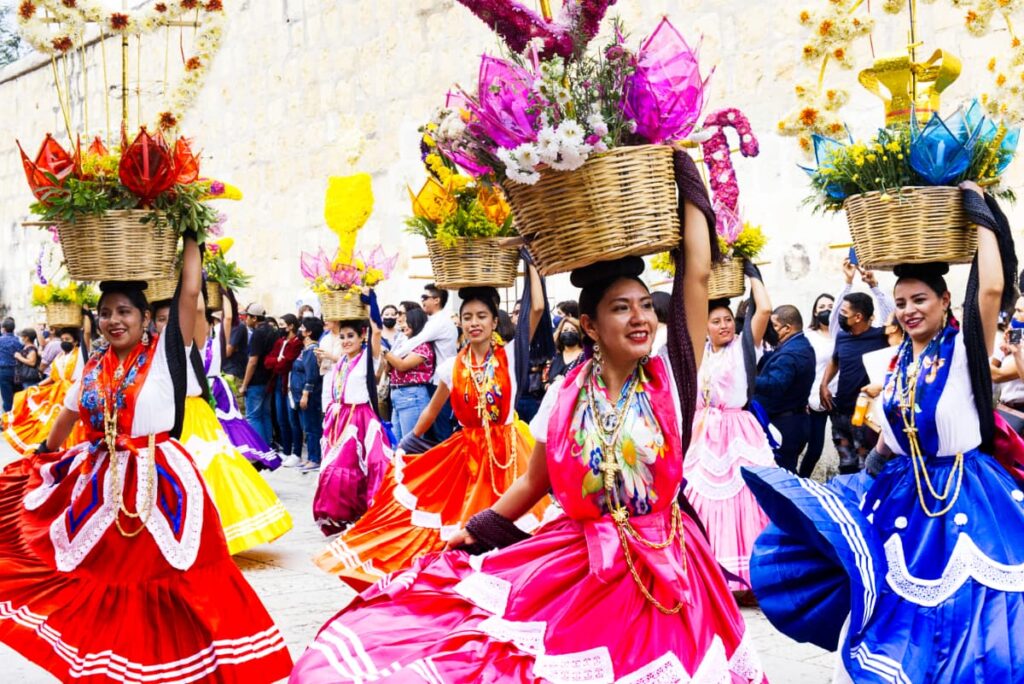
I’ve also included a few noteworthy festivals outside of the city, such as the Oaxaca Mushroom Festival and others at the coast.
To inspire your travels, here are the incredible Oaxaca festivals 2024 that you need to experience.
1. Guelaguetza: The Grand Oaxaca Festival (July)
Often referred to as “La Fiesta Máxima,” Guelaguetza is the biggest festival in Oaxaca. Its arrival is highly anticipated, with various events that occur for weeks leading up to the start of the festival.
The Guelaguetza Festival celebrates the cultural diversity of the eight regions of Oaxaca. On display are the rich traditions of the 16 different ethnic groups in Oaxaca.
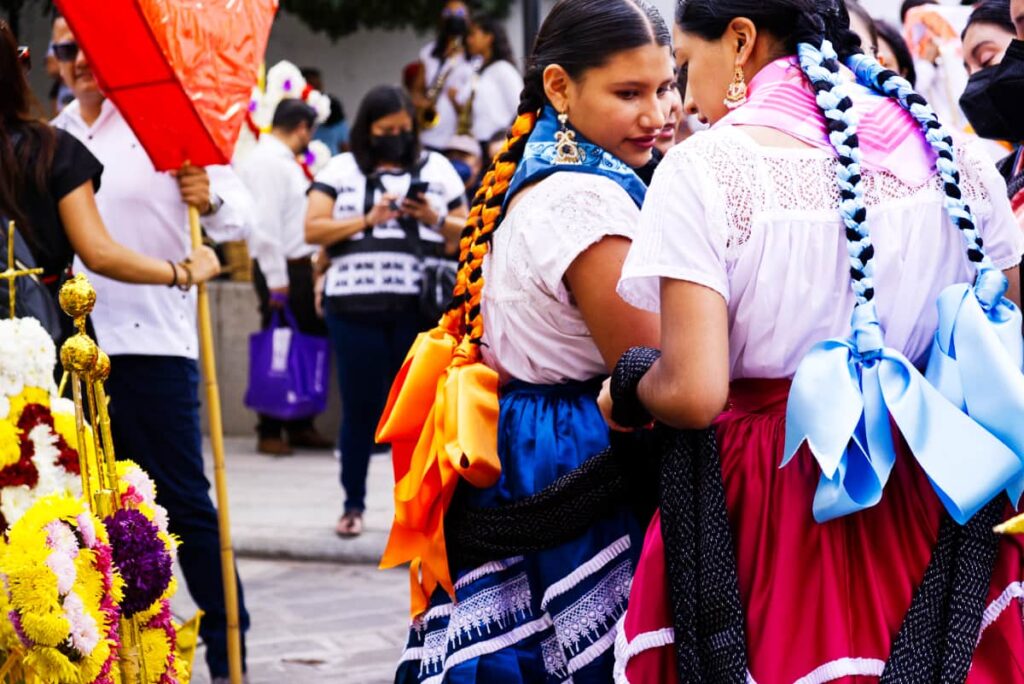
Incredibly, the roots of this Oaxaca festival begin with the Zapotecs, before the arrival of the Spanish. That means the Guelaguetza Festival is over 500 years old!
The Zapotecs had an idea to bring communities together to collaborate and exchange traditions. Much like the festival today, there was traditional music, dancing, dress, and food to be shared.
The main events occur on two consecutive Mondays in mid to late July at the Guelaguetza Auditorium in Oaxaca City.
Although in my opinion, some of the best events happen outside of these dates and in small towns throughout the state of Oaxaca.
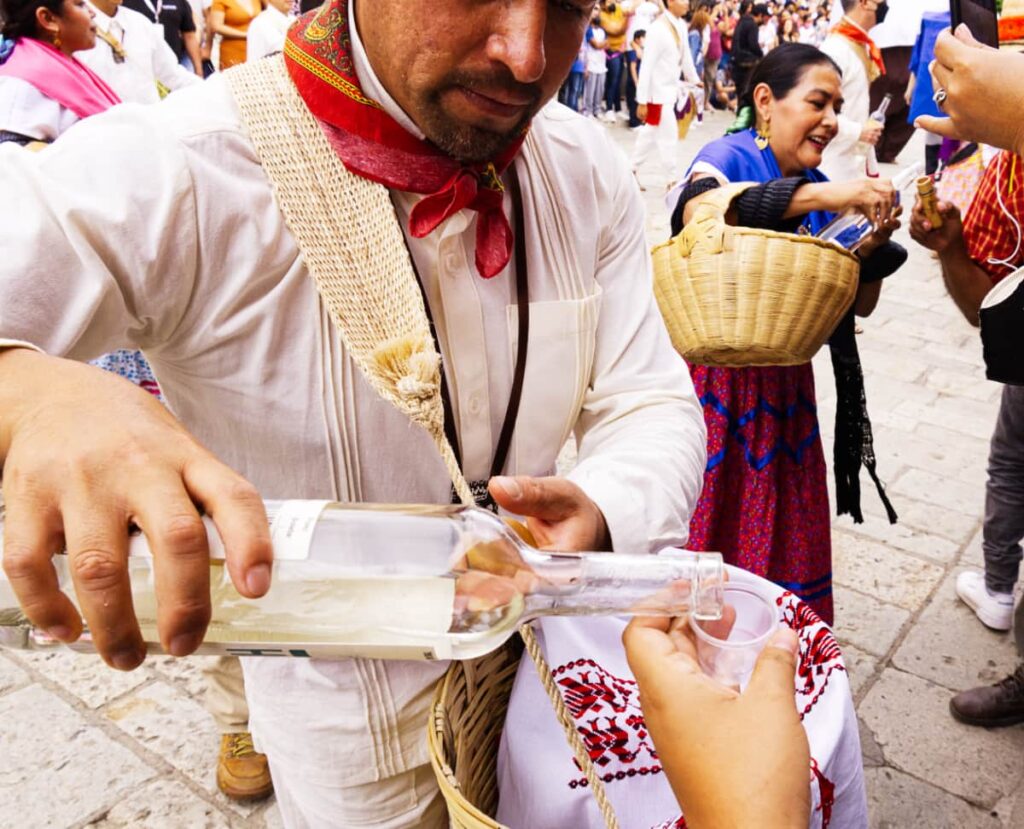
2. Oaxaca Mezcal Festival (July)
Mezcal lovers rejoice!
There is a festival in Oaxaca dedicated to the beloved spirit of Mezcal, for which the area is known.
Located in the Convention Center, La Feria de Mezcal (The Mezcal Fair) showcases over 125 Oaxacan companies. While the focus is Oaxacan mezcal, the participants have expanded to include local beer brewers, coffee producers, traditional foods, and artisans.
At the Oaxaca Mezcal Festival, you’ll be able to learn about different types of agaves, the mezcal distillation process, and of course taste a variety of locally produced mezcal.
This event takes place around the same time as the Guelaguetza Festival, perfect for combining two Oaxaca festivals.
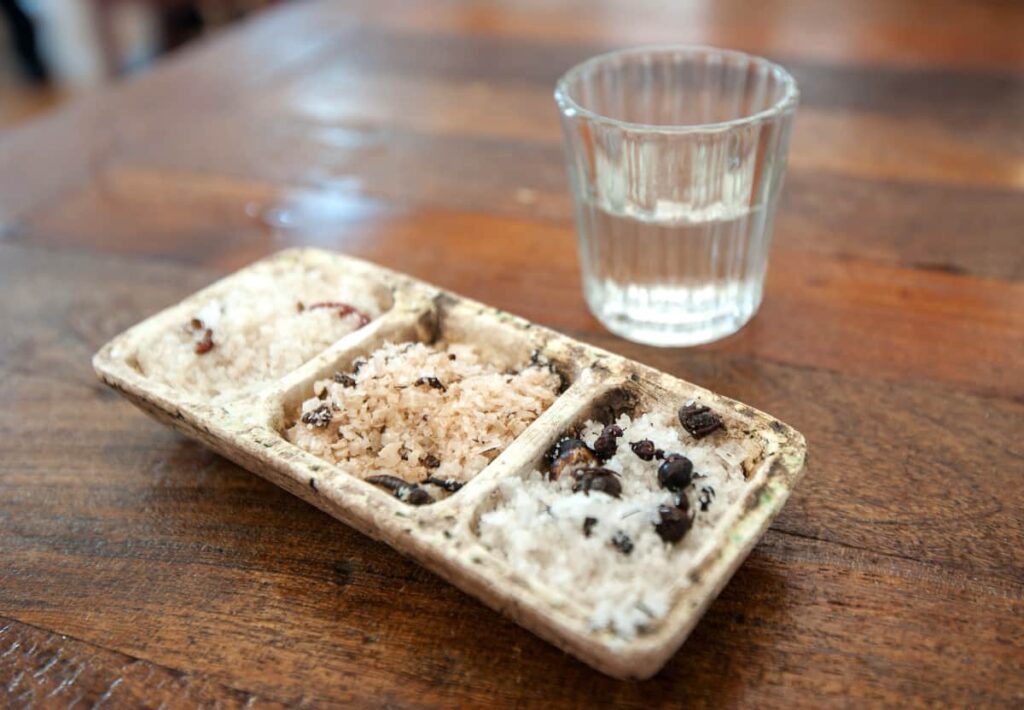
Bonus Oaxaca Festival: La Gran Fiesta del Mezcal (July)
As the self-proclaimed “World Capital of Mezcal,” the town of Santiago Matatlán has recently started its own mezcal festival.
La Gran Fiesta del Mezcal (The Great Mezcal Party) is scheduled over five days during the Guelaguetza Festival.
Participating mezcal producers will offer tastings as well as palenque and distillery tours. You can find out more about specific events on their Facebook page.
3. Day of the Dead – Dia de los Muertos (November)
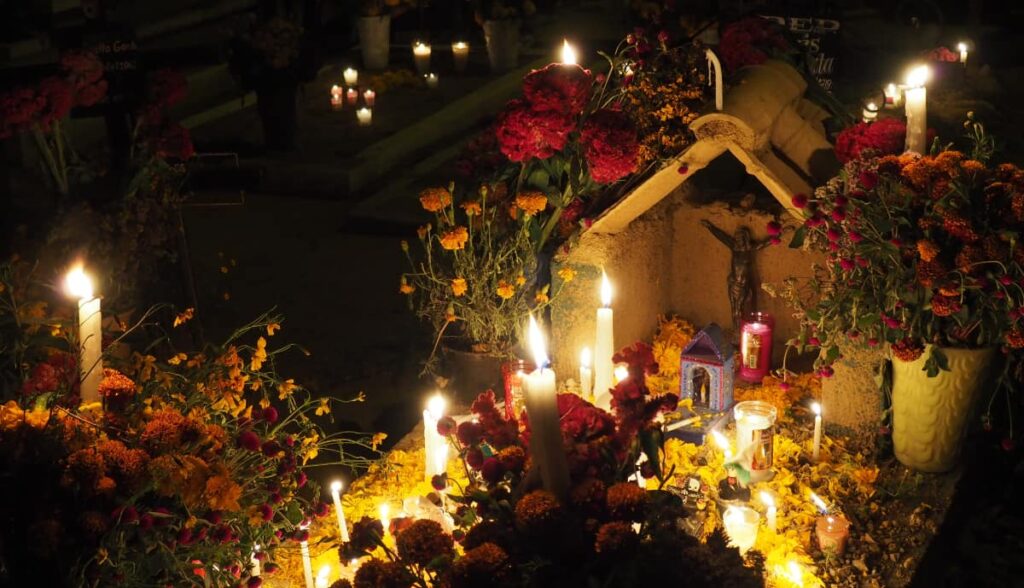
No list of Oaxaca festivals would be complete without Day of the Dead, or Dia de Muertos.
This festival draws a large number of international visitors who are interested in learning about how Mexicans regard death and the afterlife. And there’s no better place to experience this beautiful celebration than Oaxaca.
Day of the Dead in Oaxaca is still rooted in tradition. Families gather in the evenings to visit with the spirits of the deceased, who they believe visit during this time.
It’s a celebration of life and of death. So like any celebration in Oaxaca, there are incredible parades and other events throughout the city.
The entire city is awash in decorations, with altars and flowers taking over the buildings.
It’s a magical time to be in Oaxaca.
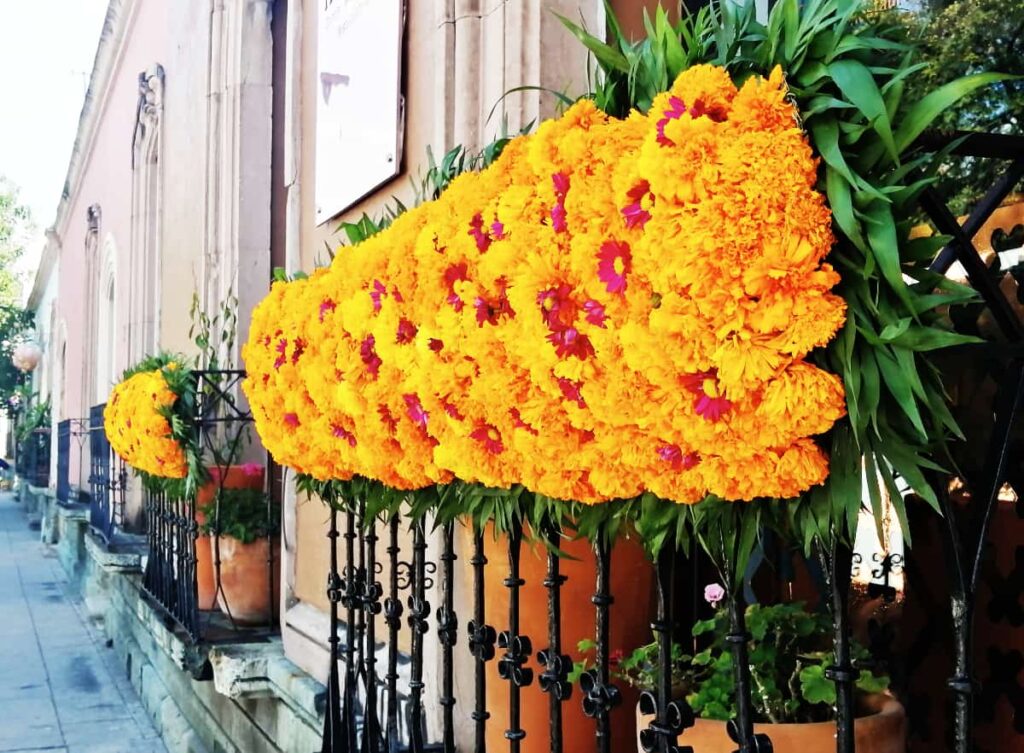
When is Day of the Dead in Oaxaca?
Day of the Dead is celebrated on November 1st and 2nd, though technically it starts the night of October 31st when it’s believed souls of the dead arrive to visit.
In addition, Day of the Dead in Oaxaca fills the air in the preceding days. I recommend arriving at least a few days before to really soak up the energy.
4. December Celebrations in Oaxaca
If you visit Mexico in December, expect loud nights and early mornings with cohetes (homemade fireworks) and parties throughout the month and into the new year.
December celebrations start a little earlier in Oaxaca with the pilgrimage to Juquila on December 8th which draws more than 20,000 pilgrims. Although Mexicans typically start the celebration the night before the actual festivity, so expect a noisy night on the 7th.
Then on the night of the 11th, you’ll likely need earplugs again when all of Mexico celebrates the Virgin de Guadalupe on December 12th with fireworks lasting from night into the next day.
Then a week later, the patron saint of Oaxaca, La Virgin de la Soledad, is celebrated on the 18th of December, with the largest parade of the year taking place on the Saturday before.
The calenda lasts all night, with nearly all the Oaxaquena Chinas participating as they parade throughout the entire city. And in reality, the Christmas celebrations have yet to truly begin.
While I’ve detailed the most anticipated December festival below (The Radish Festival), you’ll want to read my guide to Christmas in Oaxaca if you plan to visit the city during that time.
5. Night of Radishes (December)
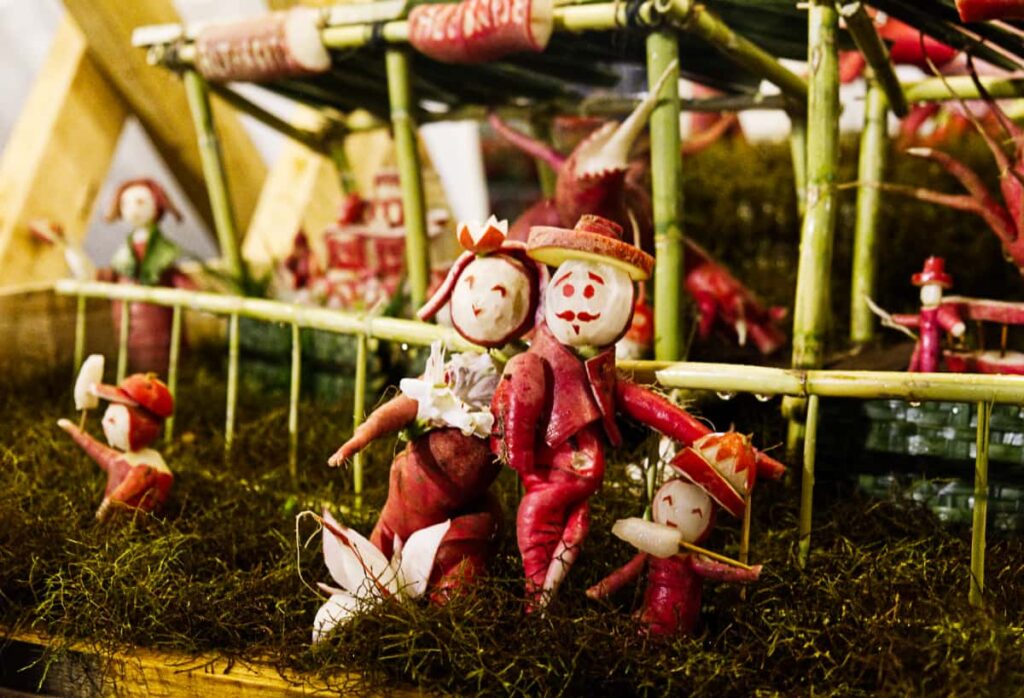
This quirky Oaxaca festival started over 100 years ago. The focus of Noche de Rabanos is red radishes, or specifically a radish carving competition.
To kick off the Oaxaca Radish Festival, artisans begin carving their oversized radishes in the Zocalo on the morning of December 23rd. This is a great time to visit so that you can see the details and works in progress up close.
Then, return to the Zocalo in the evening to see the finished products. Since these carved radishes have a limited lifespan of a few hours, there are often long lines to see these works of art.
Also on display are pieces made with corn husks and dried flowers, often with the same religious theme as the radishes.
6. Fandango Costeno (December)
While the celebration only lasts one day, this will go down as one of my favorite festivals in Oaxaca, up there with Carnaval (see next). Fandango Costena brings a taste of the La Costa region to Oaxaca City.
In early December, Plaza de la Danza becomes the center for this festival which features traditional dances of the region. There are some interesting food items to sample, including deer and armadillo tamales.
I recommend arriving for one of the later performances so that you can join the traditional calenda (parade) that starts around 6 pm. Plus, they save one of the most fun performances for last.
When I saw the men wearing fur chaps and various devil masks covering their faces, I knew we were about to have a good time. Then when I saw the large torito, a bull figure made of natural materials and wrapped in explosives, I got excited about the calenda.
What I didn’t realize is that towards the end of their performance, the dancers from Santa Catarina Mechoacan would light the bull and invite the audience on stage to dance to El Burro Loco.
We had an incredible time dancing around the stage with the bull in the center, sparks from the explosives falling to the ground. This energy continued through the calenda as we paraded through Oaxaca City to Santo Domingo.
7. Carnaval (February)
Carnaval is one of my favorite festivals in Oaxaca.
It’s the last day of temptation. The last day to sin before Lent begins. And nothing is held back.
The costumes are marvelous and the energy is vibrant.
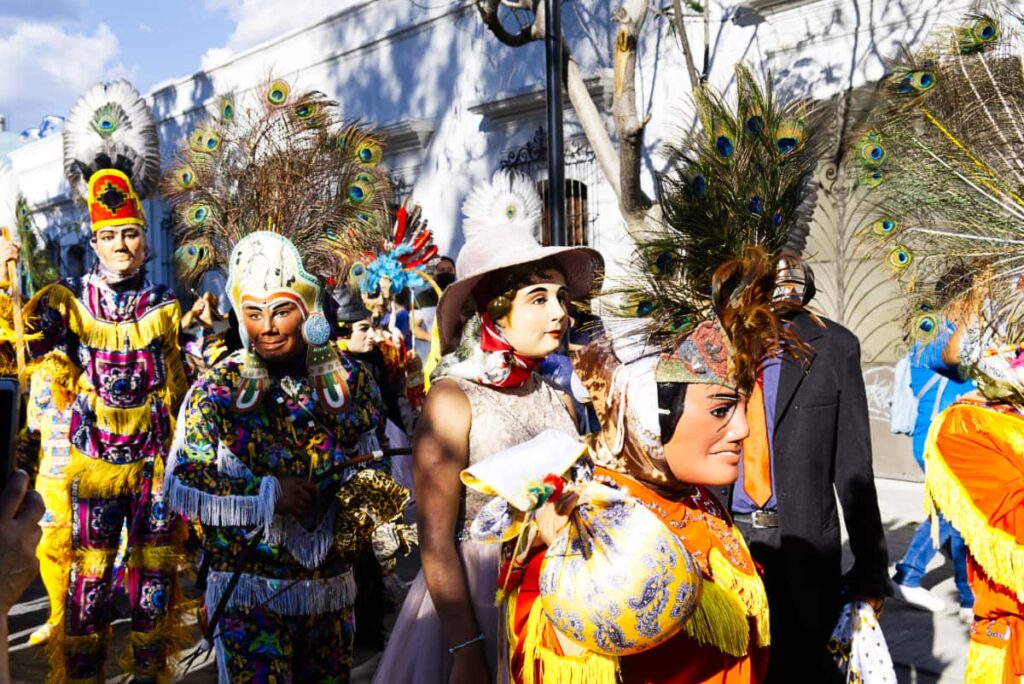
Pueblos in the state of Oaxaca celebrate Carnaval with different costumes and traditions specific to their community. But you don’t need to travel all over the state of Oaxaca to see these incredible costumes.
On Saturday before Lent begins, over a dozen communities travel to Oaxaca City to represent their community in one big parade.
It starts at Plaza Cruz de Piedra and travels past Santo Domingo, down the Andador, and to the Zocalo.
The central location is convenient and the event gives you a fascinating view of the different Carnaval celebrations in Oaxaca.
For the full experience, travel an hour south of Oaxaca City to the San Martin Tilcajete Carnaval. It takes place on the Tuesday before Lent, or what is called “Fat Tuesday” in the United States.
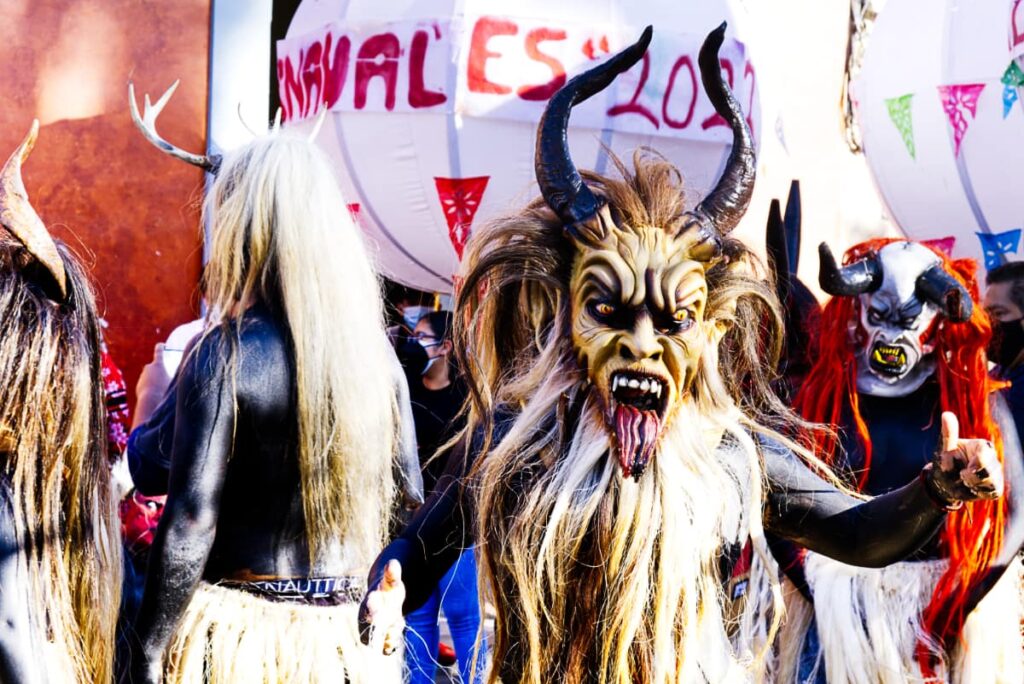
When Is the Carnaval Festival in Oaxaca?
The dates of Carnaval change from year to year since it is based around Easter. Typically Carnaval takes place in late February.
The Carnaval parade in Oaxaca City is held on Saturday before Lent begins. Actually, there is also a second parade on the Saturday following but I found the first parade to be more energetic.
8. Easter in Oaxaca: Semana Santa (April)
After Carnaval, Oaxaca City is dusted a light purple for Lent.
In Xochimilco, one of the oldest neighborhoods in Oaxaca, purple and white papel picado flutter above the streets. And doorways throughout the city are framed with woven palm leaf decorations that are sold in the markets of Oaxaca.
There are parades and other events throughout the week during Semana Santa in Oaxaca. It begins on Palm Sunday with the blessing of palms and a procession from the Cathedral of Oaxaca.
On Jueves Santo (Holy Thursday), the Visit to the Seven Houses leads Oaxacans through the churches in the historic center.
And you shouldn’t miss the most noted event, the meditative Procession of Silence, which takes place on the evening of Good Friday. The Archbishop of Oaxaca leads this procession from the Catedral Metropolitana, up the Andador, and past Santo Domingo Church.
During this week, the Catedral Metropolitana also hosts religious concerts featuring a choir and organ music. And the neighborhood of Xochimilco organizes several small events near the church.
Oaxaca is always in a state of fiesta. When someone is born, there is a lot of music, also when someone dies. And between the two, we dance and enjoy life.
JOSÉ OCTAVIO AZCONA Y JUÁREZ
OAXACA’S PRIMIERE MONERO (GIANT PUPPET MAKER)
9. Good Samaritan’s Day (March)
Dia de la Samaritana, or Good Samaritan’s Day, is a purely Oaxaca festival that occurs on the fourth Friday of Lent. It’s a wholesome celebration where Oaxaqueños and visitors receive glasses of agua fresca from various churches, businesses, and homes throughout the city.
Agua fresca, which literally translates to “fresh water,” is water flavored with fresh fruits, herbs, flowers, and/or other ingredients.
You’ve probably had one while eating at a food stand or local restaurant. Most common are agua de jamaica, agua de tamarindo, and horchata.
The tradition of Good Samaritan’s Day originates from a biblical story of a thirsty Jesus who asked a Samaritan woman for water and she obliged.
Tip – Bring your own cup for this festival. Oaxaca City recently asked everyone to bring their own in an effort to cut down on waste. I love that many Oaxacans embrace being eco-friendly!
10. Oaxaca Festival of Traditional Chefs (April)
For one weekend in late April, the aromas of the eight regions of Oaxaca fill the air at Plaza de la Danza.
Cocineras Tradicionales de Oaxaca is a gastronomic event that brings together 50 chefs and over 150 traditional dishes from Oaxaca. In addition, there are various sweets, nieves, and ancestral Oaxacan drinks.
To showcase the food from Oaxaca there are a variety of soups and stews, tamales, and specialty dishes that are typically reserved for special occasions. And the stand that caught everyone’s attention was that from San Juan Bautista in which the chefs consistently rotated skewered half pigs over a fire throughout the weekend.
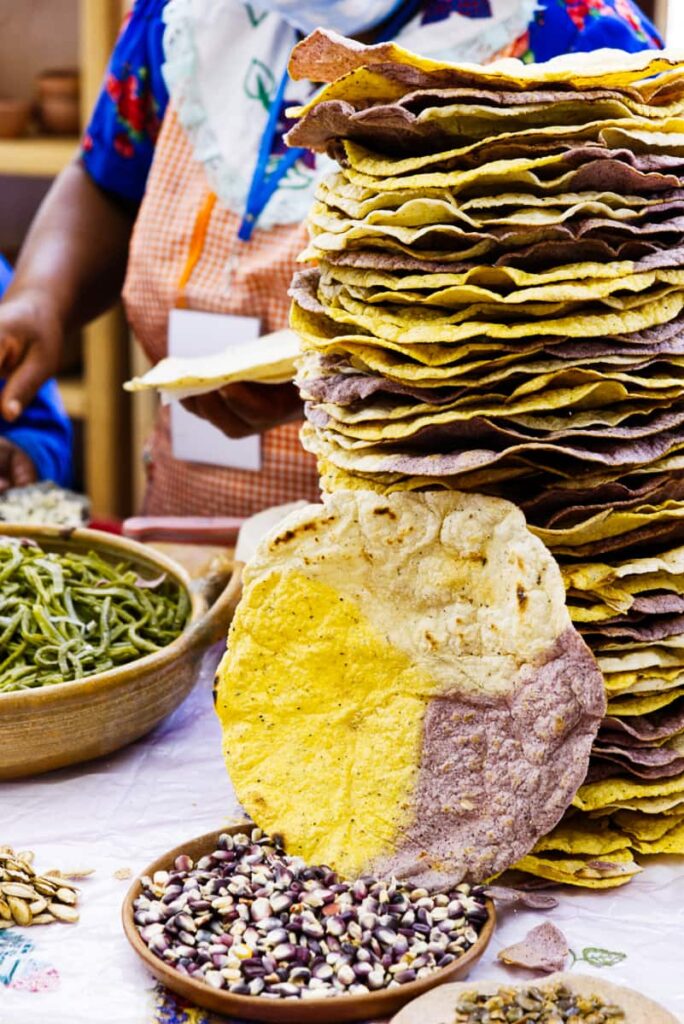
The events of this festival also include over a dozen various gastronomic presentations (in Spanish) throughout the weekend. You can find more information and the schedule on their Facebook page.
Furthermore, there was no use of plastic in sight, a rarity for an event like this. Food and drinks were either served on ceramic dishes or paper products and the silverware was real. Admission to the festival is free and the dishes average 70 pesos.
If you find yourself in the city during this time, you should definitely support and eat your way through this festival in Oaxaca, which aims to promote and preserve traditional Oaxacan cuisine.
Bonus Festival in Oaxaca: Feliz Cumpleaños (April)
The site of what we now called Oaxaca City has been occupied for thousands of years by Mixtecs, Zapotecs, and other indigenous groups. Each of these communities had different names for the area.
The city of Oaxaca was founded in 1532, after the conquest of the Spanish who built the colonial city we know today. And that is the year that is celebrated as Oaxaca’s Birthday.
There’s not a lot going on for this celebration which occurs around the end of the Festival of Traditional Chefs. But, it is an opportunity to purchase weavings and other Oaxaca artisan works without taking a day trip to the surrounding villages.
The artisan market is set up along the walking street, just north of Santo Domingo Church. In addition, there is a comparsa (parade) on the afternoon of April 25th.
11. Oaxaca Mushroom Festival (August)
This festival opens up the mystical world of fungi.
In this case, we are talking about wild mushrooms (called hongos) for cooking, rather than the other kind that has made San Jose del Pacifico popular.
In Mexico, there are about 2,000 common names for edible mushrooms, many of which come from indigenous languages.
And it is estimated that indigenous communities consumed around 200 species of mushrooms in addition to mushrooms for healing and rituals.
A mushroom festival in Oaxaca has been held for over 15 years in the Sierra Norte town of San Antonio Cuajimoloyas. However, since the Pueblos Mancomunados have been closed for the last two years, this festival has taken a hiatus.
Recently a new Oaxaca mushroom festival emerged in the town of San Mateo Rio Hondo.
For two and a half days in early August, the Festival del Hongo includes talks about mushrooms, nature walks to forage for wild mushrooms, tastings, and a contest of traditional dishes using hongos. And it wouldn’t be a Oaxaca festival without a calenda (parade) to kick things off!
You can find out more on their Facebook page. All of the events are free except the mushroom walk. For 200 pesos per person, the walk includes a water bottle or commemorative hat, a refreshment, and a knowledgeable guide.
Important – You should only forage for mushrooms with a guide that is knowledgeable about edible mushrooms in the area. For this reason, this mushroom festival in Oaxaca is a great way to learn about the local mushrooms.
Bonus Mushroom Festival Oaxaca (August)
There is another Oaxaca Mushroom Festival in the forest near Tlaxiaco in mid August. Fiesta de los Hongos Mixtecos is an opportunity to taste, learn, and share about the culture of mushrooms from the Mixteca region.
There are mushroom walks with local guides, gastronomic events, traditional music and dance, a temazcal, and more. The mushroom festival takes place at Hotel y Cabañas Yucunuvichi (map) and you can find more information on their Facebook page.
There are various packages depending on the activities you are interested in attending, some of which include transportation from Oaxaca City.
Other Food Festivals in Oaxaca
Oaxacan food is so celebrated that you may time your trip for one of the regional food festivals in Oaxaca without even realizing it. I’ve highlighted a few of these below.
12. La Feria de Empanada de Mole Amarillo (December)
During the last days of December, Empanada de Mole Amarillo Festival in San Antonino Castillo Velasco celebrates this popular food. And bonus, it’s proximity to Santa Catarina Minas means you’ll likely sample some of the best mezcal in Oaxaca.
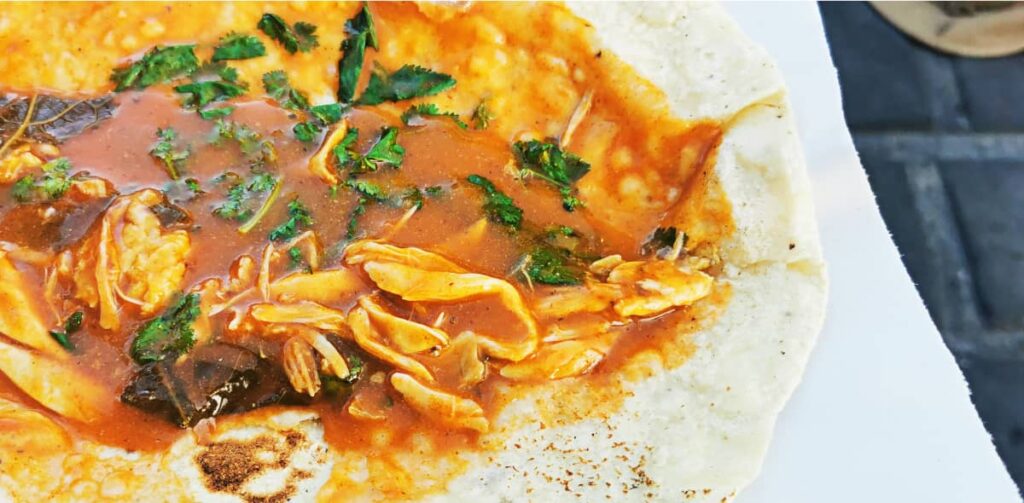
13. Mole de Caderas Festival (October)
October brought a lesser known traditional food to Oaxaca City. The Festival de Mole de Caderas caused quite a discussion among locals, many of which had never heard of this dish.
Its origins were debated between Huajuapan de León Oaxaca and Tehuacan, Puebla. But what could be agreed upon was that dish from the Mixteca region is a yearly tradition.
Goat hips (caderas) are cooked into a brothy soup when the goats of the region are slaughtered. You can also find at this festival is tetelas, one of my favorite snacks but one that is hard to find in the city.
14. Tejate Festival in Huayapm Oaxaca (April)
Referred to as the “Drink of the Gods,” tejate is celebrated in Huayapam, where the flowers used to make this drink grow. Around Easter, the town celebrates with variations of this traditional drink.
You’ll also find foods from the region such as empanadas verde, memelas, and lamb barbacoa. The tejate festival is rounded out with local ice cream (nieves), crafts, and musical performances.
15. Festival del Mole Costa y Mixteca (August)
This festival is held at the Zicatela Market in Puerto Escondido. It unites two regions of Oaxaca – La Costa and the La Mixteca while featuring traditional cooks, mezcal producers, and artists.
16. Los Cachudos: Santa María Coyotepec (July)
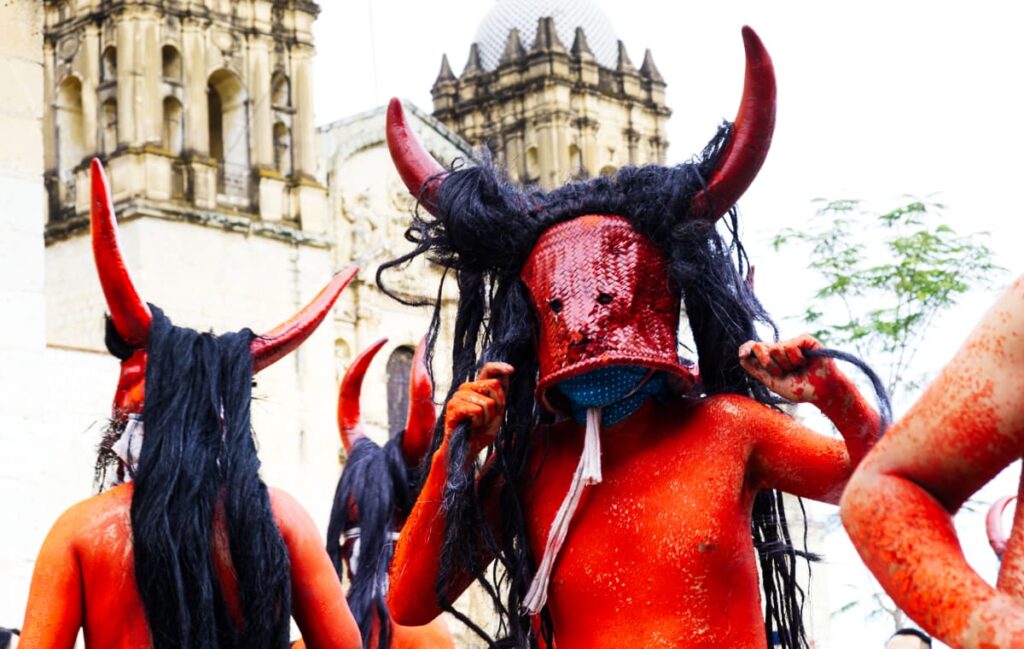
Celebrate the tradition of Los Cachudos on July 9th in the town of Santa María Coyotepec, about 20 minutes south of Oaxaca City. This festival mixes Meso-American tradition with Christianity as it celebrates the arrival of the rains and honors Santa Isabel from Portugal.
The festivities begin with a parade through the streets of Santa María Coyotepec where you’ll find men dressed as devils (Los Chachudos). Much like Oaxaca Carnaval, their bodies are painted in various colors and their faces are covered with masks made of natural materials.
Like most festivals in Oaxaca, this is a celebration with free-flowing mezcal. So you’ll want to get some food in your stomach as well. When the parade finishes, you’ll be invited to sit down to a plate of traditional food.
After eating, suddenly everyone departs. But the festival isn’t over. They’re headed to the horse races! This is an incredibly fun Oaxaca festival without a lot of foreigners.
17. Guelaguetza in Puerto Escondido (November)
There are secondary versions of the Guelaguetza Festival throughout the state of Oaxaca and throughout the year. But this is one of the biggest, bringing the dances and traditions of the biggest Oaxaca festival to Puerto Escondido.
It’s held at one of the busiest times of the year, just after Day of the Dead when many tourists travel to the coast. It’s a great way to combine two of the most iconic festivals in Oaxaca.
18. Chila Oaxaca Festival (February)
While you won’t run out of things to do in Puerto Escondido, if you’re visiting in February you should consider traveling to Bajos de Chila for their annual festival.
The festivities begin at the beginning of the month to celebrate the patron saint of Chila. The events include rodeos, horse races, and pelota Mixteca, the traditional hand ball game dating back to pre-Hispanic times.
The festival wraps up two weeks later with a spectacular fireworks show on Valentine’s Day (see the video below).
19. La Vela Muxe: Vela de las Intrépidas (November)
Now let’s travel towards the coast of Oaxaca and to the town of Juchitán de Zaragoza for La Vela Muxe, a unique festival in Oaxaca.
In this town, located in the Isthmus of Tehuantepec region of Oaxaca, they recognize a third gender, called muxe.
Muxes (pronounced MOO-shays) are born male, although many adopt roles traditionally associated with women. They have been celebrated by the Zapotecs since pre-Hispanic times and some consider it lucky to have a muxe as a child.
The festival began in the 1970s when the muxe of Juchitán were subject to judgment and persecution within their community. The muxe banded together and formed a group by the incredible name of the Authentic, Intrepid Seekers of Danger.
Each year in November, they host a series of parties called velas. If you decided to attend this Oaxaca festival, keep in mind the Istmo area is quite traditional about the velas.
Attendees are required to wear traditional dress and abide by local customs. It’s best if you know someone from the area as even then, I didn’t feel completely comfortable.
20. Nudist Festival in Zipolite, Oaxaca (February)
Continuing to the coast, let’s make a stop in Zipolite, Oaxaca, the only legal nude beach in Mexico. During the first weekend of February, they host a festival that brings nudists to this hippie beach town.
To kick off the Zipolite nudist festival, there is a body painting event followed by a traditional Oaxacan parade down the beach at sunset. The parade ends on the beach at the main stage in front of the letters of Zipolite.
Throughout the weekend there are other events such as a pool party, snorkeling boat tour, Zumba class, beach volleyball tournament, a mezcal tasting, and much more. A program of events is published on the official Facebook page a few weeks before the nudist festival.
21. Jazz Festival in Mazunte (November)
For over a decade, the International Jazz Festival of Mazunte has been held in this small beach community during the third weekend in November.
In addition to supporting Mexican musicians, this festival takes on a tone of cultural and environmental conservation.
There are opportunities to taste the food of Oaxaca and purchase local crafts, as well as participate in a turtle release and other eco-friendly events.
In addition, there are other activities in Mazunte at the same time such as yoga classes, art exhibitions, and pre-Hispanic dance performances.
Final Thoughts About Oaxaca Festivals
Can you feel the rich culture that flows through many of these festivals? If you’ve visited Oaxaca, you know that vibrant energy can be felt throughout the city. On any given day you may run into a parade or other special event.
But there is nothing like experiencing one of these Oaxaca festivals firsthand. Which festival in Oaxaca are you most excited about experiencing?

